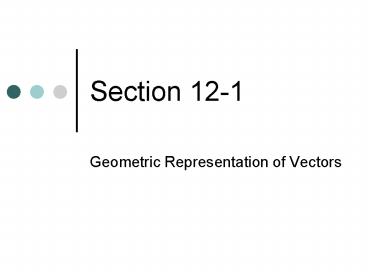Geometric Representation of Vectors PowerPoint PPT Presentation
1 / 21
Title: Geometric Representation of Vectors
1
Section 12-1
- Geometric Representation of Vectors
2
Vectors
- Vectors are quantities that are described by a
direction and a magnitude (size). A force would
be an example of a vector quantity because to
describe a force, you must specify the direction
in which it acts and its strength. Velocity is
another example of a vector.
3
Vectors
- The velocities of two airplanes each heading
northeast at 700 knots are represented by the
arrows u and v in the diagram on p. 419. We
write u v to indicate that both planes have the
same velocity even though the two arrows are
different.
4
Vectors
- In general, any two arrows with the same length
and the same direction represent the same vector.
The diagram on p. 419 shows a third airplane
with speed 700 knots, but because it is heading
in a different direction, its velocity vector w
does not equal either u or v.
5
Magnitude
- The magnitude of a vector v (also called the
absolute value of v) is denoted v.
6
Addition of Vectors
- If a vector v is pictured by an arrow from point
A to point B, then it is customary to write v
. Since the result of moving an object first
from A to B and then from B to C is the same as
moving the object directly from A to C, it is
natural to write . We say that
is the vector sum of and .
7
Addition of Vectors
- The addition of two vectors is a commutative
operation. In other words, the order in which
the vectors are added does not make any
difference. You can see this in the diagrams on
p. 420 where the red arrows denote a b and b
a having the same length and direction.
8
Addition of Vectors
- If the two diagrams on p. 420 are moved together,
a parallelogram is formed. This suggests that
another way to add a and b is to draw a
parallelogram OACB with sides a and
b. The diagonal of the parallelogram
is the sum. - This method is frequently used in physics
problems involving forces that are combined.
9
Vector Subtraction
- The negative of a vector v, denoted v, has the
same length as v but the opposite direction. The
sum of v and v is the zero vector 0. - It is best thought of as a point.
- v (-v) 0
10
Vector Subtraction
- Vectors can be subtracted as well as added.
- v w means v (-w).
11
Multiples of a Vector
- The vector sum v v is abbreviated as 2v.
Likewise, v v v 3v. The diagram on p. 421
shows that the arrows representing 2v and 3v have
the same direction as the arrow representing v,
but that they are two and three times as long.
12
Multiples of a Vector
- In general if k is a positive real number, then
kv is the vector with the same direction as v but
with an absolute value k times as large. If k lt
0, then kv has the same direction as v and has
an absolute value k times as large. If k ? 0,
then is defined to be equal to the vector
.
13
Scalars
- When working with vectors, it is customary to
refer to real numbers as scalars.
14
Scalar Multiplication
- When this is done, the operation of multiplying a
vector v by a scalar k is called scalar
multiplication. This operation has the following
properties. If v and w are vectors and k and m
are scalars, then - k(v w) kv kw
- (k m)v kv mv
- k(mv) (km)v Associative law
Distributive laws
15
True or False?
16
Complete the statement.
17
Homework p. 423-424 1-9 odd
18
Homework p. 423-424 1-9 odd
19
Homework p. 423-424 1-9 odd
20
Homework p. 423-424 1-9 odd
21
Homework p. 423-424 1-9 odd
- 9. A ship travels 200 km west from port and then
240 km due south before it is disabled.
Illustrate this in a vector diagram. Use
trigonometry to find the course that a rescue
ship must take from port in order to reach the
disabled ship.

